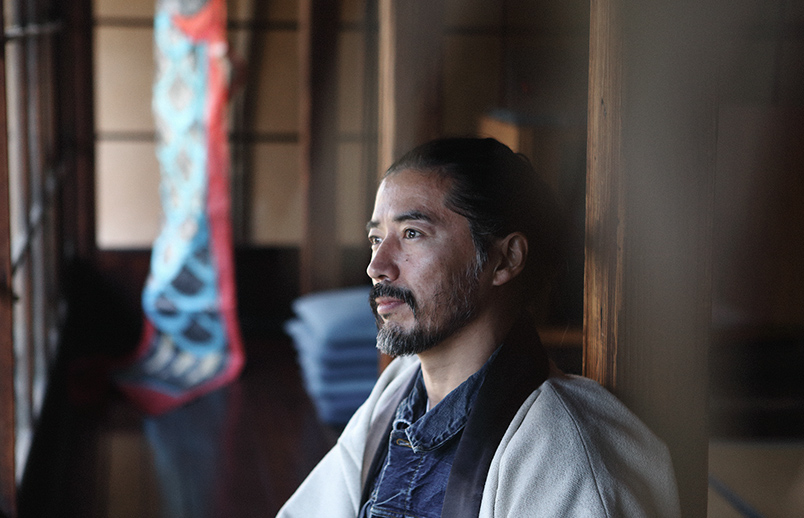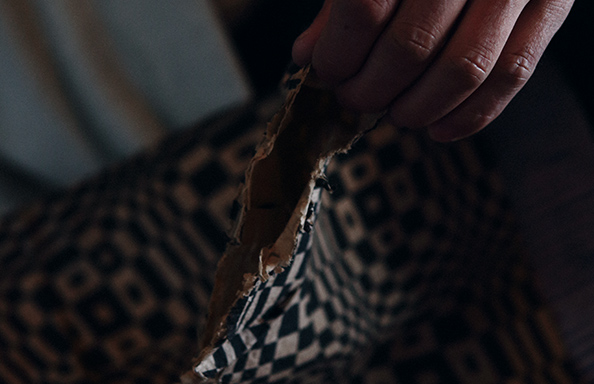Photography : Katsuhide Morimoto (little friends)
My Archive
EYE OF GYRE
2018.03.17(SAT) - 04.12(THU)




Interview with Hiroki Nakamura Making Products Begins with Emotional Resonance
Photography: Kiyotaka Hatanaka(UM) Interview & Text: Kosuke Ide Edit:Yasuyuki Takase, Naoe Hanamido(EATer)
My Archive is a series of essays by Hiroki Nakamura, Creative Director of the visvim brand, and which first appeared in POPEYE magazine in June 2012. Nakamura’s essays feature vintage pieces that have provided inspiration for his creative process of making products. Every month, Nakamura has revealed fascinating items from different times in history and from divers’e locations encompassing both the East and the West, that have continued to surprise and delight readers.
These items include Native American leather moccasins, a natural dyed Tibetan blanket, a hat worn by an Ethiopian ethnic minority, a shepherd’s umbrella from Alsace in France, an Amish child’s outfit and Inuit snow goggles through to a Japanese fire - fighter’s happi coat from the Edo Period. Of interest is the fact that, in contrast to the conventional collector who collects items from a specific time or region or products by a specific creator or brand, Nakamura selects a wide range of items for his collection, without being restricted by category.


I Choose What I’m Instinctively Drawn to and Like.
We asked Nakamura, as he prepares for this exhibition showcasing items that he has personally selected from his collection, about his thoughts behind the selection of items, how these are used, and how they influence his creativity.
“I don’t actually know for sure what the selection criteria are. It’s instinctive. I just select something that I impulsively feel is good. The impulse comes first, followed by giving it meaning from an intellectual perspective. This order is extremely important, because I think something essential is lost when it’s the other way around. When a product’s being sold, it often comes as part of a set, in the sense that it’s accompanied by some sort of context, such as its history, brand or scarcity value. However, being aware of the product’s profile doesn’t necessary mean you ‘get’ that product. That’s because it doesn’t speak to your sensibility. Sensibility is something that’s extremely important to me. A new product is created by first linking my emotional response to my intellectual response and process, and then to explore this in my own way and reconstruct it. That’s why I always want to look at something without any preconceptions. It’s not easy to do, but I always remain very conscious of this.”
Techniques from the past are slowly being forgotten or have become completely forgotten. However, according to Nakamura, he doesn’t aim to simply revive form or technique in a way that’s superficial.
“Much of what normally inspires me are handmade items or things made from natural materials or using traditional techniques, but this doesn’t mean that I simply want to preserve traditional handicraft or cultures. I want to create something new that has meaning in or relevance to contemporary life by conveying the universal values and beauty that lies in the things that were created in the past. That’s why it’s not about valuing something just because it’s old, nor does it mean that I want to faithfully recreate old things. It’s simply because, compared to these contemporary times, there’s a clear rationale behind items made in the past, with many of these items conveying something pure. We want to continue to be aware of the creative process behind these simple items and to pass on these universal values to the next generation.”
I’m Drawn to Things That are Uneven.
My Archive Interview with Hiroki Nakamura


What’s the essence behind the universal values and beauty
of handmade items that resonates with you?
“With the advancement of technology, you could say that everything in this digital world has become flat. However, I’m drawn to things that are uneven. That’s because I believe that unevenness represents humanness. For example, the Tibetan robe made with yak fur has been unevenly dyed, while the stitching is also crooked and the silhouette asymmetrical. However, the Tibetans had no intent or awareness of creating something that’s symmetrical. And that’s because perfect symmetry simply doesn’t exist in the natural world. That’s just the way it is. I actually think it’s a bit creepy to place importance on achieving perfection in everything. I’m also drawn to people with unusual personalities, who are unique.”


With the Act of Making Things Comes Responsibility.
My Archive Interview with Hiroki Nakamura
And to conclude, we asked Nakamura about his views on the “SHOP & THINK” concept behind GYRE.
“I believe that the act of making things comes with responsibility, and that’s why I want to create something that has meaning in contemporary life and which will be relevant to the next generation. I want this exhibition, which features items that I’ve been inspired by and which conveys how I interpret them, to be an opportunity to share my product - making process with others. And, more than just conveying the way I personally view things, I hope that these items will resonate in some way with every individual who sees the exhibition.”
Hiroki Nakamura
My Archive
- Period
- 2018.3.17(Wed)-2018.4.12(Thu)/11:00-20:00/Open everyday
- Organizer
- visvim
- Sponsor
- GYRE
- Support
- HiRAO INC
- Venue
- EYE OF GYRE - GYRE 3F
『My Archive』
- Author
- Hiroki Nakamura
- Issue
- Magazin House
- Size
- 265×265mm
- Pages
- 120P
- Price
- ¥3,800 (w/o tax)
















